By Jeffrey A. Rendall; Photos of Cannon Ridge By Jeff Janas
PONTRE VEDRA BEACH, FL – Most baby boomers probably cut their golfing teeth during the seventies and eighties, picking up their fathers’ sticks and playing at the local muni while trying their hardest to emulate the great players they’d seen on TV.
I know I did.
Golf was reaching its peak of popularity (which happily, continues to this day), following the careers of Jack Nicklaus, Johnny Miller, Tom Watson, Hale Irwin, Lee Trevino – and many of the players now on the Champions Tour. It might be said that Arnold Palmer brought golf to America’s living rooms, but it was the seventies and eighties that really saw the beginnings of what is now a series of professional tours, most with live TV coverage and large purses, even for the ‘minor’ tours.
This was a tremendous growth period for professional golf, and it’s safe to say, most of it went on without us really realizing what was happening. While there were many people involved in generating that increase (including the players), one man oversaw the changes, and led the way to what we see today.
That man is Deane Beman. Beman, who served as PGA Tour Commissioner from 1974 – 1994, was born and raised in Bethesda, Maryland, and as a boy he remembers hunting birds at what is now the Montgomery Mall. He’s not only witnessed the tremendous growth and change in golf, he’s seen the population expansion and change in our Washington DC region, as well.
His contributions to professional golf are many, highlighted by his work on creating the TPC (Tournament Players Club) concept (the first was TPC Sawgrass, and now there are over 25 TPC’s in many corners of the country), and he was also instrumental in founding the Champions Tour in 1980 and the Nationwide Tour in 1990.
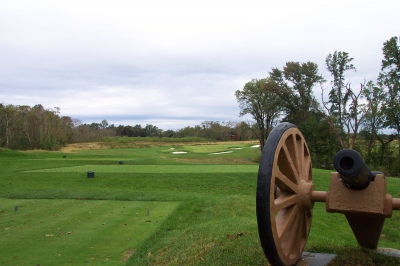 |
| Beman's Cannon Ridge is significant for golf... and for history. |
Recently, Beman’s taken his accumulated playing and managerial experience and applied it to the design of his first signature golf course at Cannon Ridge, just north of Fredericksburg. Having won a British Amateur title, two US Amateur titles, five PGA Tour events, and served as head man of golf’s top professional tour for over twenty years, he’s seen an awful lot of golf courses.
In talking with him, it was clear his foremost mission these days is trying to grow the game. It’s a well known fact that although professional golf is thriving, golf at the consumer level is somewhat stagnant. Though many new golfers are still coming to the game, many of its long-time players are giving it up due to a variety of factors. Retention is a major issue, and Beman’s doing something about it.
I caught up with him recently (which is no easy task, he’s on the road quite a lot), to talk about his work at Cannon Ridge, and he was kind enough to share his thoughts on that facility (and course design in general), as well as some other issues facing growth in golf today:
GTMA: Obviously, you were very much involved with founding the TPC concept – how did working on the TPC’s impact your thinking on designing courses for everyday golfers, like at Cannon Ridge?
Beman: Well, you’ve got to remember it’s really a completely different animal here. The courses we built as TPC’s were designed for tournament play, for professional players and to host galleries with tens of thousands of people.
In contrast, the golf course at Cannon Ridge was designed for the club player to enjoy playing the game. The intention at Cannon Ridge was not to build an obstacle course that would be too difficult for the average player to get around, and would take too much time. It’s challenging, but very playable.
So, even though there are lots of hazards out there, the golf course was designed to get around the hazards and not to have you go over them. Whereas at a TPC and the tournament golf courses, what you do is put those hazards almost directly in play, to put the maximum risk/reward into golf.
GTMA: Are you still continuing to work on some of the newer TPC’s?
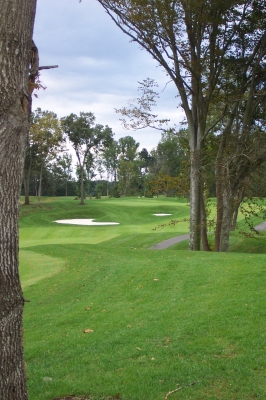 |
| The 12th hole at Cannon Ridge is pure Virginia -- and proves the designer has a keen eye for beautiful golf holes. |
Beman: No, I haven’t been involved in that for some time. When I retired, I completely retired, and I’m doing these things on my own. They continue to build TPC’s, but I haven’t been involved in any of newest ones.
GTMA: So what was it like working with Pete Dye (who designed the first and most famous TPC, at Sawgrass)?
Beman: Pete Dye is absolutely unique – I love him like a brother.
GTMA: As a designer, what else can you do to help average players?
Beman: Well, one thing we did at Cannon Ridge was work with the size of the greens.
One of the problems today in golf is -- there are lots of bad players who like to play the game, and that’s great. It’s a fun game, but they score high.
If you’ve observed average players on the golf course – they watch golf on television, and they want to walk up and stand behind each putt, and it takes forever.
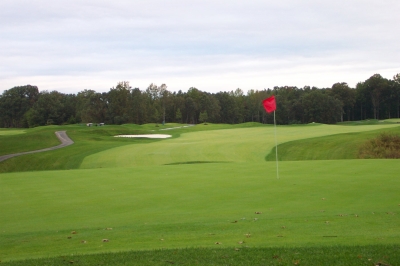 |
| Looking back from one of the most difficult holes you'll ever see -- the 5th at Cannon Ridge. |
At the same time, if they’re off the green, they’ll pick a club and hit it. They’ll see the shot they have to make, then go ahead and pitch it onto the green – and usually get fairly close to the hole. They might not get it up and down in two, but we didn’t build greens at Cannon Ridge where many people will be three-putting, which takes a lot of time.
GTMA: That’s a re-occurring theme at Cannon Ridge – in talking with your General Manager, Bob Baldassari, and now with you, that you should get around in about four hours. Rees Jones once said you shouldn’t be in a hurry to finish a round of golf. Why is it so important?
Beman: You shouldn’t have to hurry, but you also shouldn’t have to wait. People are busy, and time is precious. And let’s face it, sometimes golf takes a long time to play.
We want to keep the course at a level of conditioning where you can take the carts off the paths – but even if you’re on the paths, you can still play in four and a half hours.
The game’s more appealing when you’re able to move along and not have to wait on every shot.
GTMA: The time it takes to play is definitely a factor in keeping people interested in playing. Are there other issues that you see as major barriers to retaining golfers?
Beman: The biggest issue facing golf today, in my opinion, is the fact there are lots of people who would like to learn how to play golf, but it is too difficult to learn.
That’s why I created a new teaching system (6/90, explained below) to try and find a way to make learning the game less painful for a mature adult. It’s a way for people to start playing golf at a later age, and enjoy it in a shorter period of time.
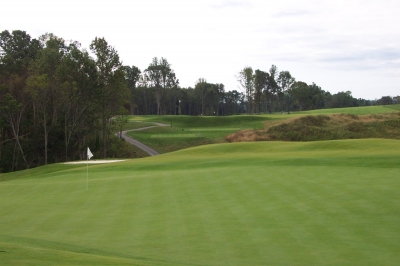 |
| Undulations, trees, golf. No houses. Pristine. |
Take women for example. If you look at statistics, you’ll find it’s something like 75/25 the ratio of men to women playing golf – and the reason is that women are very intimidated by learning to play the game.
So we’re trying to find a friendly, efficient way to change that – one that’s non-intimidating and easier for women and adult men to take up the game that we’d all like them to take up. That’s the biggest challenge facing golf today.
GTMA: What does the 6/90 program do that traditional teaching methods don’t?
Beman: First of all, it’s an experimental teaching program that starts in the spring, around March 1st. We’ll put several hundred golfers through the 6/90 system, which focuses on a golfer who’s never played before, or somebody who tried to play and ended up quitting because they were frustrated with it, and the game was too difficult.
We’ll put ‘em through a specialized system for teaching, with the objective of having them being able to shoot in the 90’s in six months.
The program’s funded through the golf industry. I personally made the original $25,000 contribution to the Foundation. It’s being operated through the First Tee at St. Augustine (Florida) – the financing, but it’s really my project. And Callaway Golf, Golf Pride, the International Golf Association that owns the World Cup, the PGA Tour – all have contributed resources for this experiment.
GTMA: Is it not for the veteran hack who’s having problems?
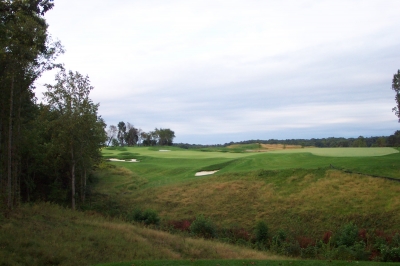 |
| Hardly the work of someone on his first project, you can tell Beman knows golf course design just from the common sense displayed in the layout. |
Beman: No, just for the group I described above. There certainly are ways to help this type of player (the ‘hack’), but the 6/90 program is for the new/returning player.
We’ve found, if you look at the history of golf the past 25 years – we’ve attracted millions of people to the game, and only a certain percentage of those people who would like to play have stuck with it because it’s too tough to learn as an adult.
So, we developed this system. It’s not really a method, it’s a whole integrated system on how to learn to play, and how to reach a level of proficiency in a very short period of time to make the game enjoyable.
As I said, it’ll start March 1st – and it’s being held at Cannon Ridge because we’ve built a driving range to handle 54 holes worth of golfers, and right now there are only 18. There’s plenty of capacity there for this program.
GTMA: Sounds interesting. I could probably use some help myself, though what golfer couldn’t? One problem I was thinking about when it comes to golf is affordability. Do you see that as an issue in attracting and keeping players in the game?
Beman: Yes, affordability’s always an issue, but it’s not one that can be solved.
Sure it’s an issue, but it’s not a barrier to lots of people who can afford to play golf who’d like to play, who have either quit in disgust, or because other people have tried, they just don’t want to go through that learning process – that long-term learning process to get to a level where they can enjoy it.
There are millions of people with plenty of resources who would like to play – but they don’t play because of the reasons I’ve just stated.
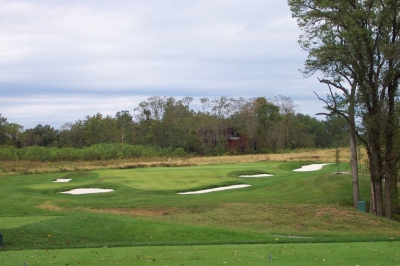 |
| Cannon Ridge's par three 15th hole looks benign, but that's a tough green to try and stick one close. |
GTMA: The answer may be obvious, but why is golf so expensive?
Beman: Land is more expensive. It costs a lot of money to build even a modest golf course – and therefore, you must achieve a certain level of revenue per round to make it work, or you’re not going to build it.
I’m a problem solver, and affordability’s not a problem that can be solved. The problem that can be dealt with is making the game easier to learn for those who want to play – so that the people who have resources and desire to play can have the opportunity to do just that.
We do have some other programs involved for affordability at the junior level.
But at the adult level, that’s not a problem that’s curable in the near term – I don’t think the governmental authorities are going to go out and subsidize golf. Though I’d rather them build 150 or 200 or 300 new golf courses in the Washington area than build a new sports stadium at taxpayers’ expense (laughs).
GTMA: I think you can pretty much count on that -- no one wants to build a stadium and pay for it. But it’s also pretty expensive to build new golf facilities, and finding land near downtown is darn near impossible. Any thoughts on that?
Beman: That’s what’s great about Cannon Ridge -- when you go to play golf in Fredericksburg, driving from the Washington area – there’s no traffic going south in the morning. None. Zippadeedoodah.
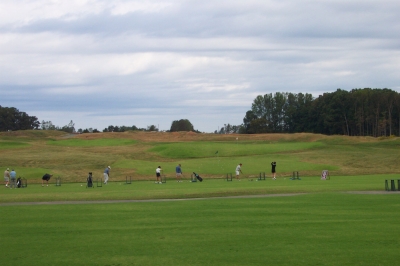 |
| The range at Cannon Ridge will host the 6/90 program. Here's growing the game in action. |
I can drive from Dulles Airport to Cannon Ridge in 58 minutes, in the middle of the morning rush at 8:30 – I’ve timed it.
In the afternoon, after you play golf all day, the rush hour’s going the other way. So it’s very, very convenient, and a wonderful reverse commute for business – it’s also a wonderful reverse commute for golfers.
GTMA: Good point. With the way things are growing in the DC area, the location’s just right.
Beman: Speaking of affordability, I think Cannon Ridge will compete favorably price-wise, too. We were able to build it at some reasonable costs, and our prices are probably 30% lower than the other higher fee golf courses in the area that cost more money to construct.
GTMA: The fact there’ll never be any houses on the golf courses, that’ll be a factor, too.
Beman: These golf courses, the first 36 holes have no development amongst the golf courses at all. You just don’t see core golf courses that much anymore with brand new golf facilities.
GTMA: What are the plans for the future of Cannon Ridge?
Beman: We have enough property for a third golf course, which is under consideration. But like any project, if you’re smart, you walk before you run.
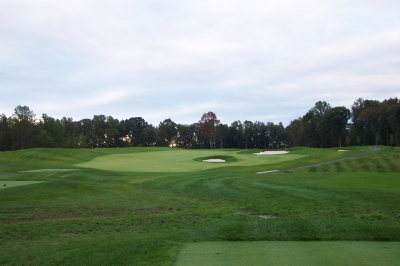 |
| From the tee on the 5th hole, there's plenty of room to bang the ball out there -- but if you want a shot at the green, you'd better hit the fairway. |
There’s a period of time to ultimately decide whether that third course will be built, and what kind of market it will serve – public or private. I’d like to think there’s enough interest and money to build the full 54 holes and keep them available to the golfing public, but we just don’t know yet.
GTMA: When looking at your design philosophies, was it important to build a walkable course at Cannon Ridge?
Beman: That was one of the elements we wanted to make sure of, that people could walk it if they wanted to. That’s part of the theme – we wanted a ‘throwback’ golf course to the classic designs, and certainly walking is part of that.
At the Cannon Ridge site, that wasn’t easy, because of the slopes and ravines that we had to contend with. I’d say it’s very walkable, with the exception of one or two places, like between the 11th green and 12th tee (Ed note: there’s a lengthy walk between the two holes, and the latter half includes a pretty steep slope to mount. Only for the brave and exceptionally physically fit).
GTMA: Cannon Ridge is on very historically sensitive ground. Civil War history in and around Fredericksburg is as meaningful as it is anywhere in the US. Were there special considerations for that?
Beman: We were very, very sensitive to the historical significance of the property, of all types.
For example, there was an archeological situation around the fifth green. We’d originally wanted it farther back on the hill – and wanted to excavate the hill so you’d be hitting down to the fifth green instead of up – but we couldn’t do that. So we moved the green forward away from the prime archeological area.
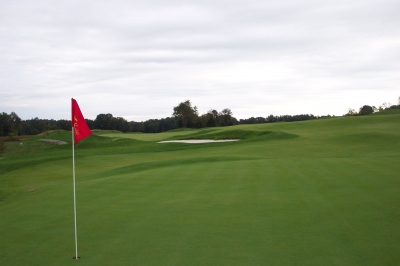 |
| Admire the panorama from the green of Cannon Ridge's 9th hole. |
We didn’t get the golf hole that we wanted, but still ended up with a great hole. Working with the historical significance of the property only enhanced the overall experience, including making for a better golf course.
GTMA: Being so close to the Rappahanock River, was there any attempt to bring it into play for some river views?
Beman: I decided, from the first time I looked at the property, that we couldn’t really do that, for a couple reasons. One, it causes lots of environmental problems if you try to do that. Second, the nature of the terrain was just too difficult.
Getting down there and getting back up would be quite a task, and you’d virtually eliminate walkability because of the drops and inclines.
You’d probably end up with some not-so-good golf holes that might be spectacular – but what might be very good and beautiful would add to the time it takes to play the golf course.
It just wasn’t worth it. It didn’t fit what we were trying to do here – and, if I might say, we’ve got a collection of truly spectacular holes as it is.
________________________________________________________________________
Beman’s right – Cannon Ridge is spectacular. And it’s hard to question the judgment of a man who’s been around golf at the highest levels his entire life.
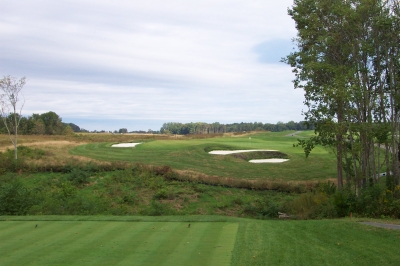 |
| It's a small ravine to carry, but the 17th hole is pure enjoyment. Beman at his best. |
Beman’s experience and good sense leads to a visually pleasing and playable layout in his first signature design. He’s put his money where his mouth is at Cannon Ridge – he’s one of the owners. One can only think that’s a sure sign that Cannon Ridge will be a major player in his attempts to grow the game.
And we’re all be better off for it.
Details:
Thanks to Deane Beman and Bob Baldassari for the story behind Cannon Ridge, truly a unique place in
For the individual review of Cannon Ridge, click on the link below, which includes contact information and rates.
| Related Links | Comments on this article? | |
|
Maryland National Golf Club Hollow Creek Golf Club Rocky Gap Resort PB Dye Golf Club in Ijamsville Whiskey Creek Golf Club |
E-mail Jeff Rendall, Editor: jrendall@golftheunitedstates.com |












